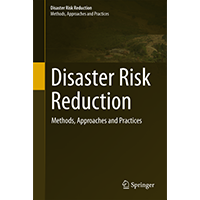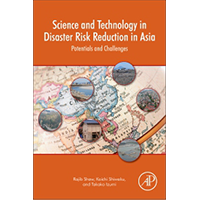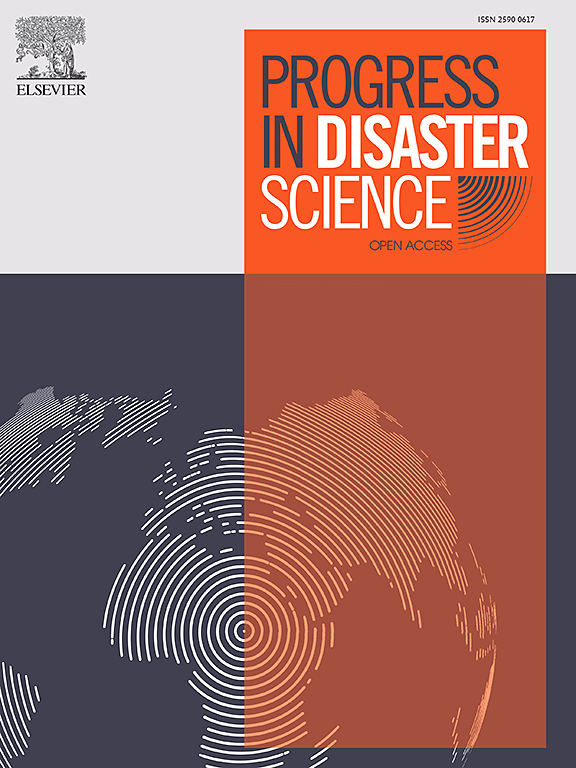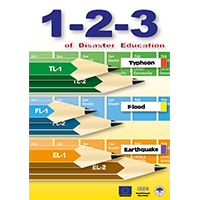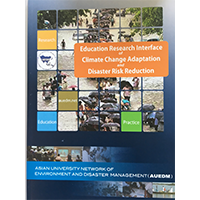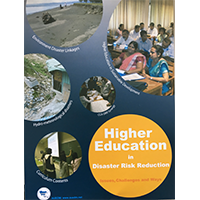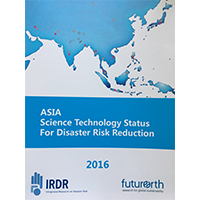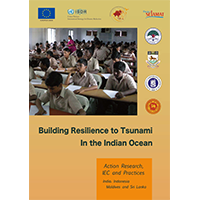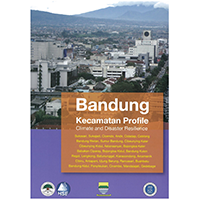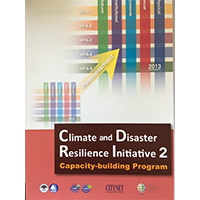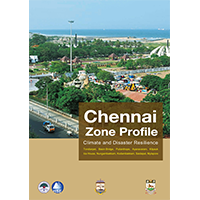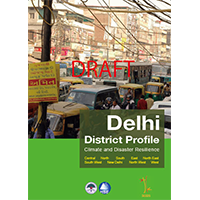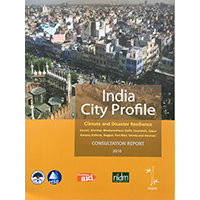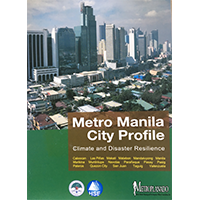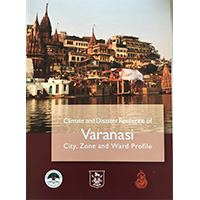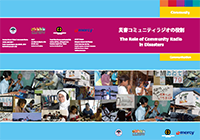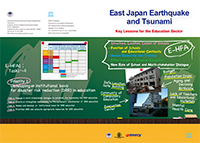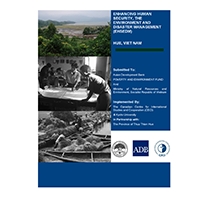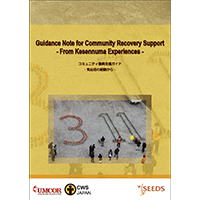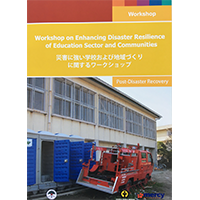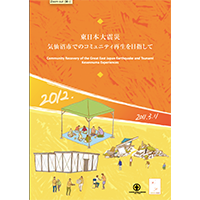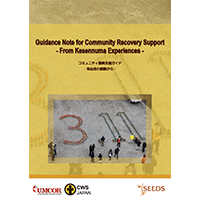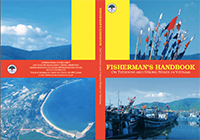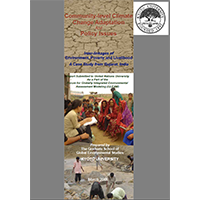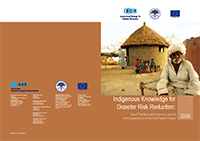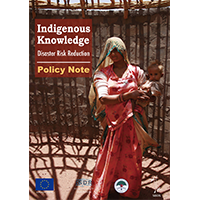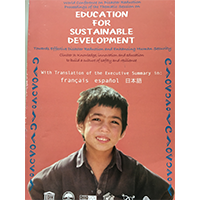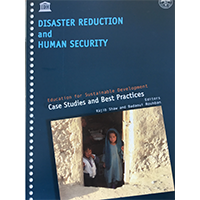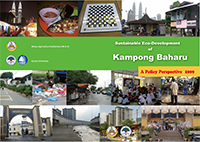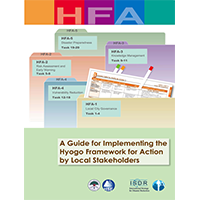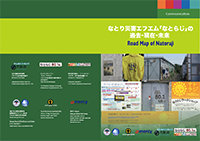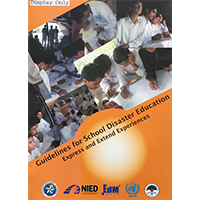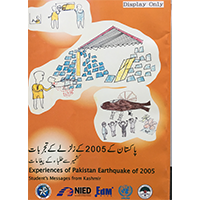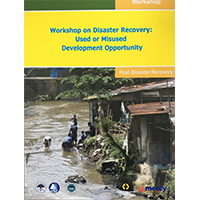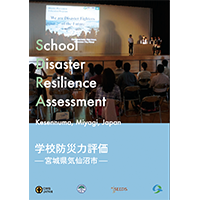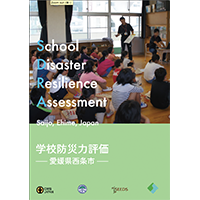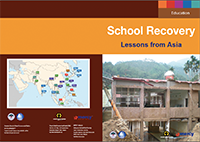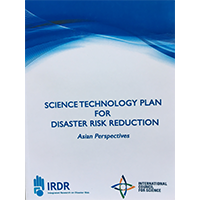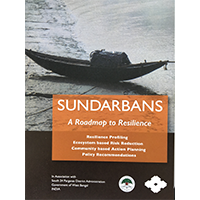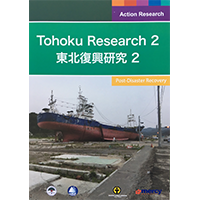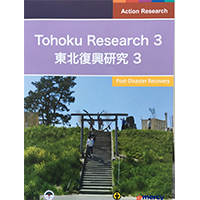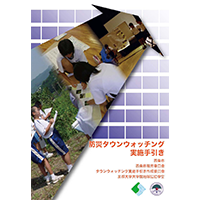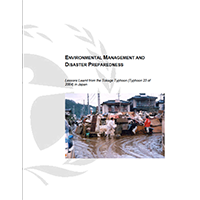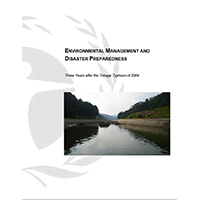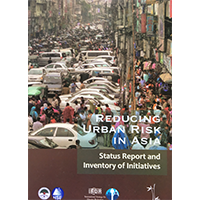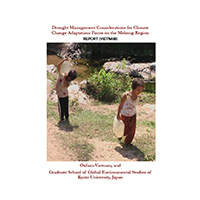- Yan W., Galloway W., Shaw R. (2024): Resilient and adaptive Tokyo: towards sustainable urbanization in perspective of Food-energy-water nexus, Springer publication, 298 pages.
Book
 EE Handbook
EE Handbook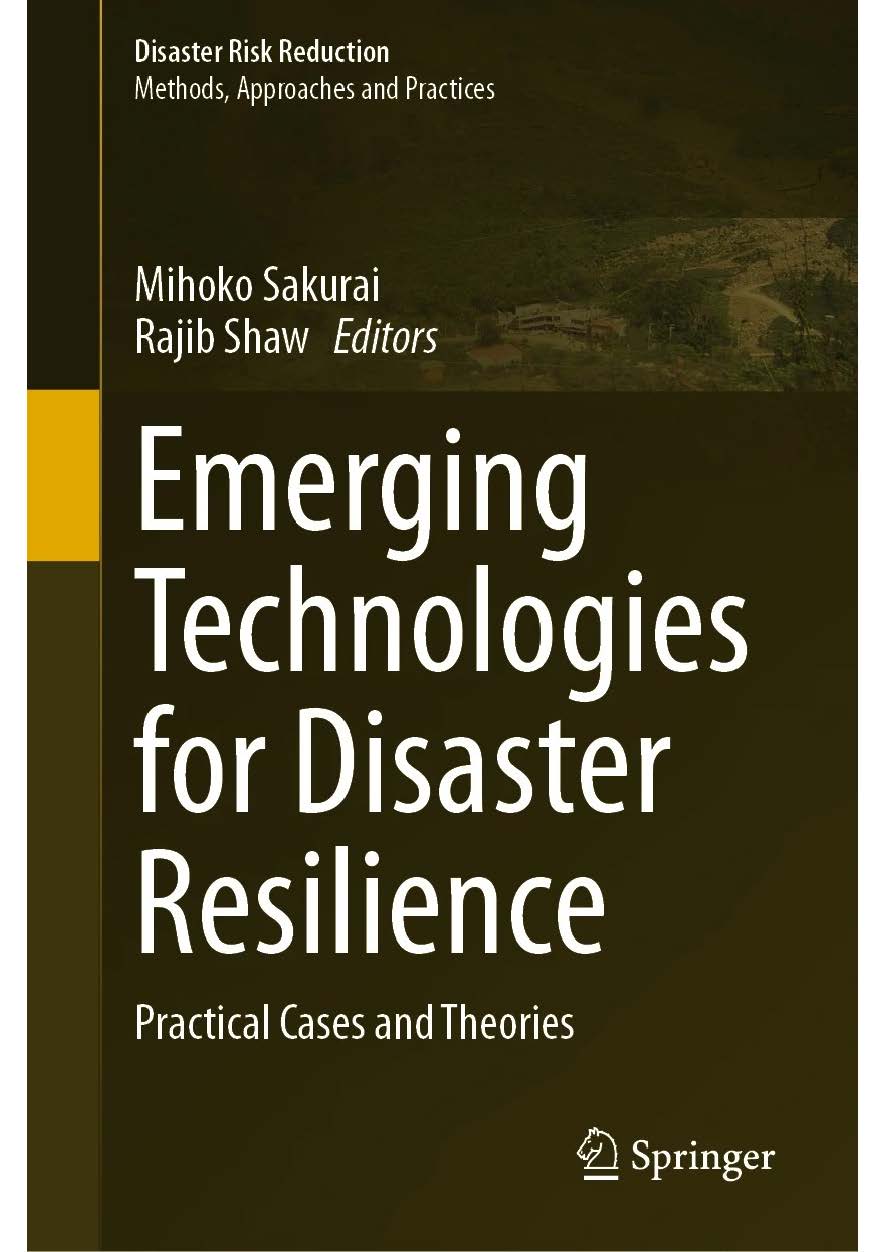 Emerging Technologies
Emerging Technologies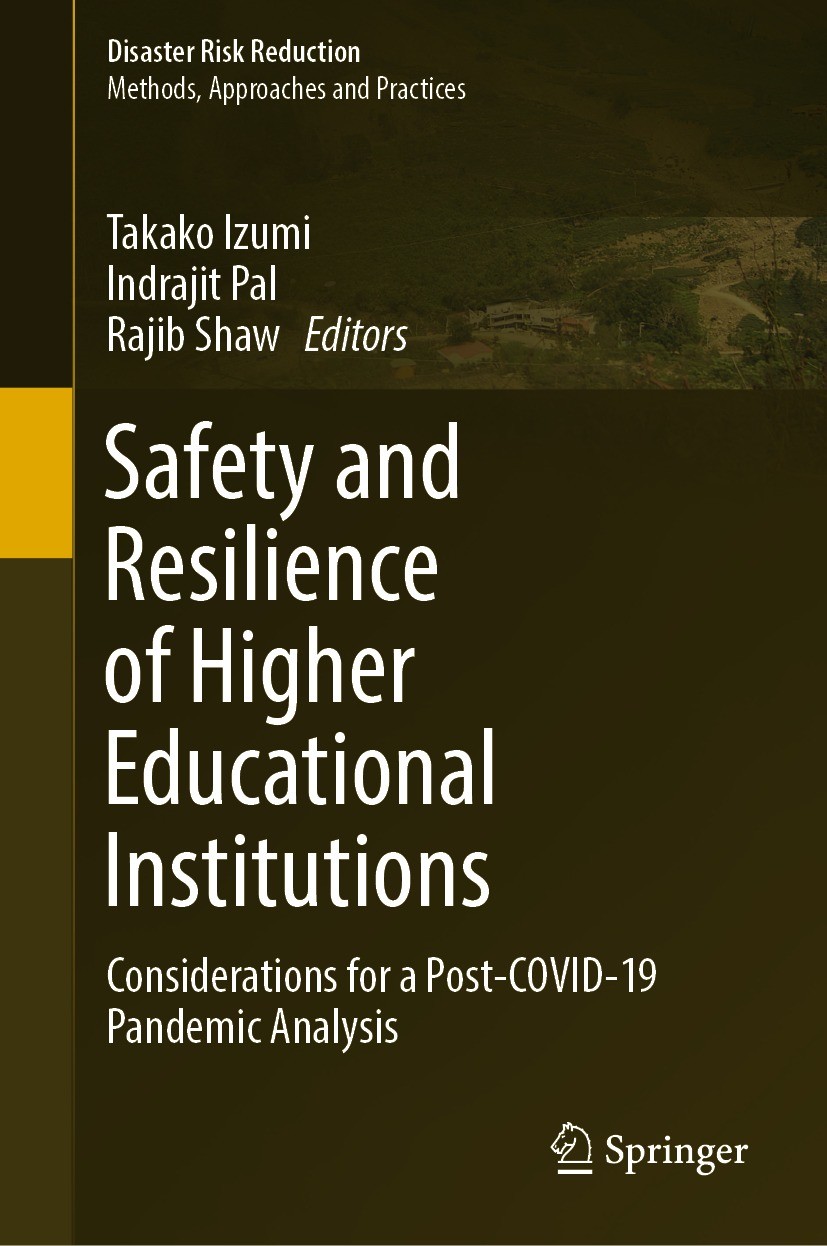 Higher Educational Institutions
Higher Educational Institutions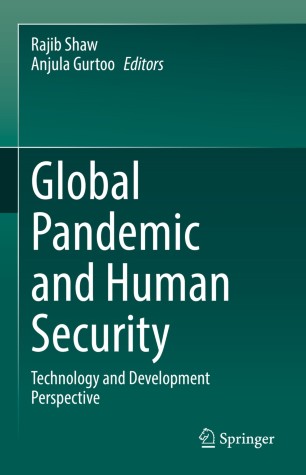 Human Security
Human Security Media and DRR
Media and DRR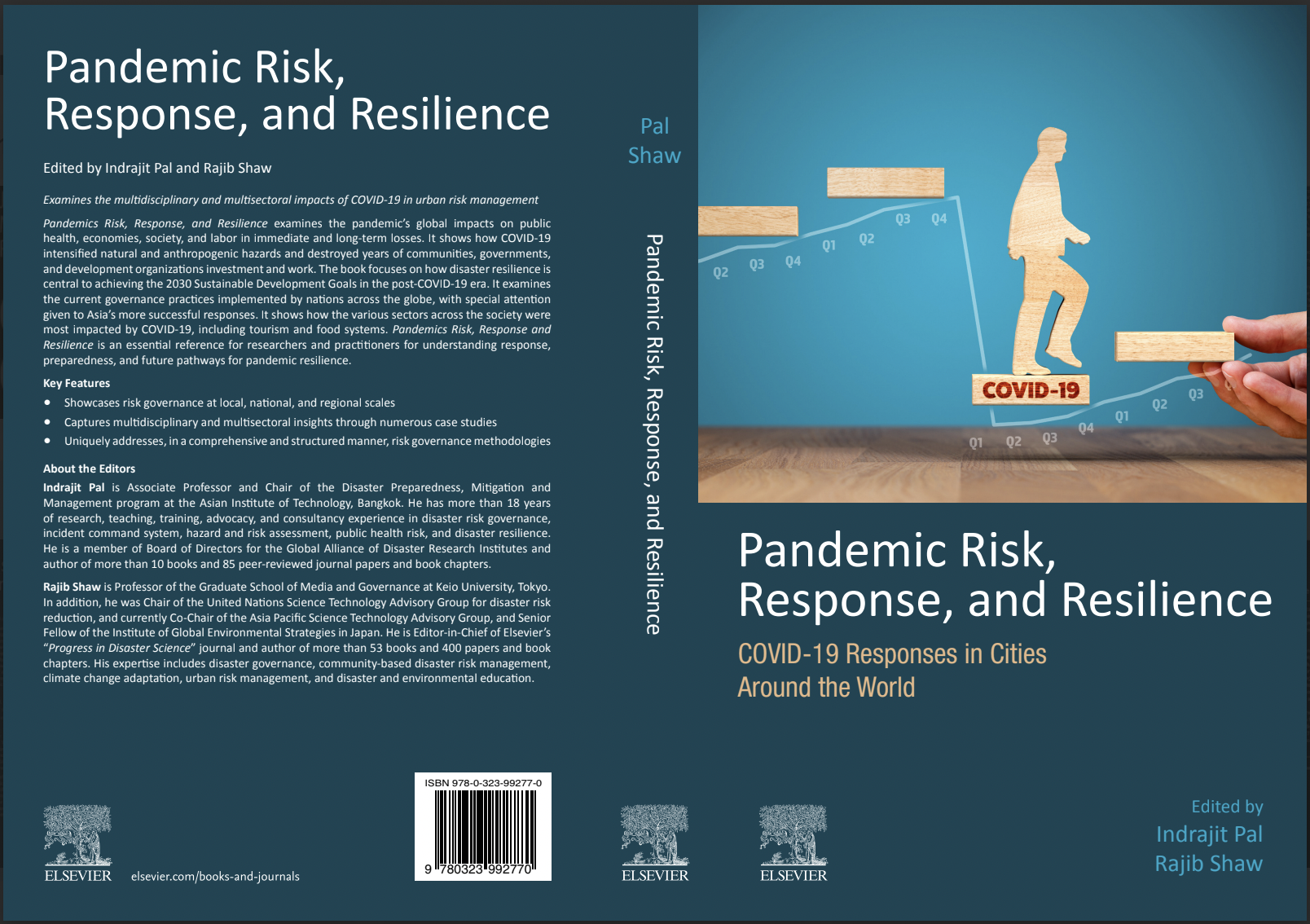 COVID 19
COVID 19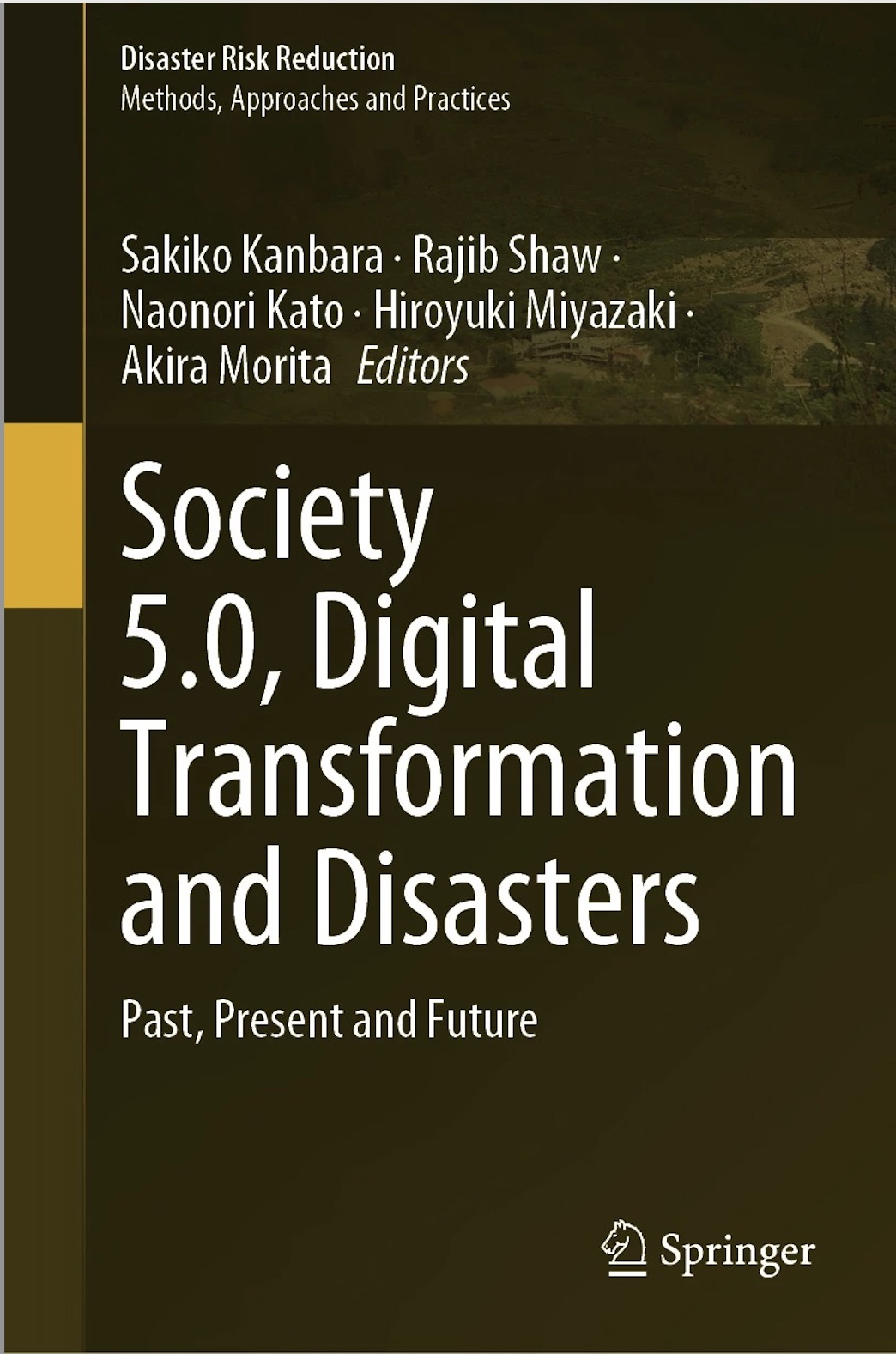 Society 5.0
Society 5.0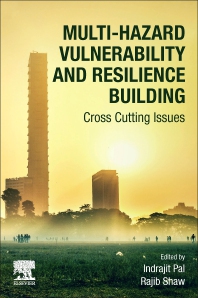 Multi-hazard Vulnerability
Multi-hazard Vulnerability Bousai kyoiku
Bousai kyoiku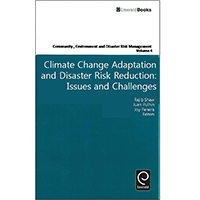 CCA and DRR 1
CCA and DRR 1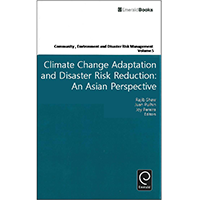 CCA and DRR 2
CCA and DRR 2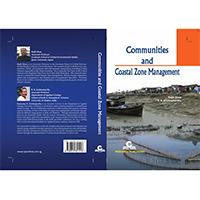 Communities and Coastal Zone Management
Communities and Coastal Zone Management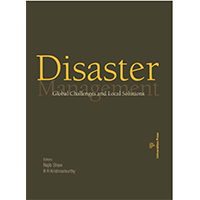 Disaster Management
Disaster Management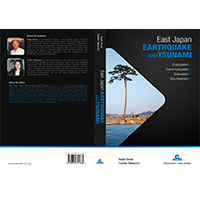 East Japan Tsunami 1
East Japan Tsunami 1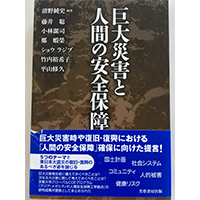 East Japan Tsunami 2
East Japan Tsunami 2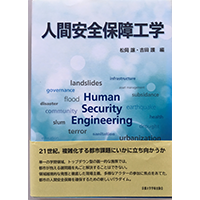 Huamn security
Huamn security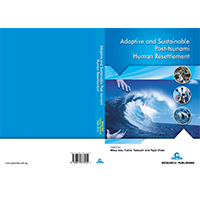 Human settlement
Human settlement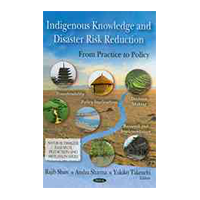 Indigenous Knowledge
Indigenous Knowledge Occupational resilience
Occupational resilience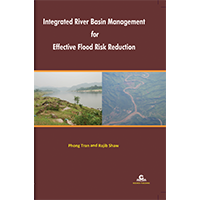 River Basin
River Basin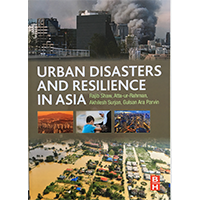 Urban resilience
Urban resilience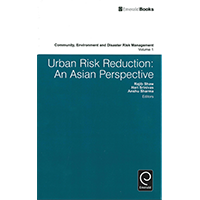 Urban Risk Reduction 1
Urban Risk Reduction 1 Urban Risk Reduction 2
Urban Risk Reduction 2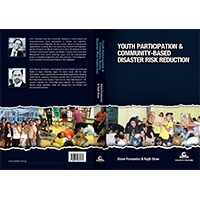 Youth Participation
Youth Participation- Pal I. and Shaw R. (2023): Multi hazards vulnerability and resilience building: cross cutting issues, Elsevier publication, 414 pages.
- Chatterjee U., Shaw R., Bhunia G. S., Setiawati, M., Banerjee S. (2023): Climate Change, Community Response and Resilience: Insight for Socio-Ecological Sustainability, Elsevier publication, 572 pages.
- Chatterjee U., Shaw R., Kumar S., Raj A. D., Das S. (2023): Climate Crisis: Adaptive Approaches and Sustainability, Springer, 588 pages.
- Shaw R. (2022): Handbook on climate change and disaster, Edward Elgar Publisher, 710 pages
- Kanbara S., Shaw R., Kato N., Miyazaki H. and Morita A. (2022): Society 5.0, Digital Transformation and Disasters: Past, Present and Future, Springer, 217 pages
- Shaw R. and Gurtoo A. (2022): Global pandemic and human security: technology and development perspective, Springer, 433 pages
- Ray P. and Shaw R. (2022): Technology, entrepreneurship and sustainable development, Springer Publisher, 342 pages.
- Izumi T., Pal I. and Shaw R. (2022): Safety and resilience of higher educational institutions: Considerations for a Post-COVID-19 pandemic analysis, Springer Publisher, 264 pages.
- Pal I. and Shaw R. (2022): Pandemic risk, response and resilience: COVID-19 responses in cities around the world, Elsevier Publication, 518 pages
- Pal I., Shaw R., Ichinose T., Yonariza, Oda T. (2022): Proceedings of the 2nd international symposium on disaster resilience and sustainable development, Lecture Notes in Civil Engineering, Springer, 338 pages
- James H., Shaw R., Sharma V. and Luckasiewicz A. (2022): Disaster Risk Reduction in Asia Pacific: Governance, Education and Capacity, Palgrave MacMillan, 391 pages
- Hua J., Adu-Gyamfi B. and Shaw R. (2022): Considerations for a post-COVID-19 technology and innovation ecosystem in China, Springer, 179 pages.
- Sarkar R., Shaw R. and Pradhan B. (2022): Impact of Climate Change, Land Use and Land Cover, and Socio-economic Dynamics on Landslides, Springer, 491 pages.
- Pereira J., Zain M. K., Shaw R. (2021): Climate change adaptation in southeast Asia, Springer, 233 pages.
- Mukherjee M. and Shaw R. (2021): Ecosystem-Based Disaster and Climate Resilience: Integration of Blue-Green Infrastructure in Sustainable Development, Springer, 588 pages.
- Pal I., Shaw R., Djlante R. and Shrestha S. (2021): Disaster resilience and sustainability: adaptation for sustainable development, Elsevier, 834 pages.
- Sakurai M. and Shaw R. (2021): Emerging technologies for disaster resilience: Practical cases and theories, Springer, 260 pages.
- Shaw R., Kakuchi S. and Yamaji M. (2021): Media and disaster risk reduction: advances, challenges and potentials, Springer, 249 pages.
- Pulhin J., Inoue M. and Shaw R. (2021): Climate change, disaster risk and human security, Springer, 445 pages
- Djlante R., Bisri M., Shaw R. (2021): Integrated research on disaster risk, Springer, 357 pages.
- Chan E. and Shaw R. (2020): Public health and disasters: health emergency and disaster risk management in Asia, Springer, 343 pages.
- Ray B., and Shaw R. (2019): Urban drought: Emerging water challenges in Asia, Springer Publisher, 427 pages.
- Shaw R., Shiwaku K. and Izumi T. (2017): Science and technology in disaster risk reduction: Potentials and challenges, Elsevier Academic Press, 525 pages.
- Pal I. and Shaw R. (2017): Disaster risk governance in India and cross cutting issues, Springer Publisher, 413 pages
- Djalante R., Garschagen M., Thomalla F. and Shaw R. (2017): Disaster risk reduction in Indonesia: progress, challenges, and issues, 668 pages.
- Das Gupta R. and Shaw R. (2016): Participatory Mangrove Management in a Changing Climate: Perspective from Asia Pacific, Springer Publisher, 338 pages
- Banba M. and Shaw R. (2016): Land use management in disaster risk reduction, Springer, 473 pages.
- Shaw R., Rahman A., Surjan A. and Parvin G. (2016): Urban Risk Reduction: Asian perspective, Elsevier Publisher, 370 pages.
- Shiwaku K., Sakurai A. and Shaw R. (2016): Disaster resilience of education systems: Experiences from Japan, Springer, 241 pages.
- Uitto Y. and Shaw R. (2015): Sustainable Development and Disaster Risk Reduction, Springer, 287 pages.
- Srivastava N. and Shaw R. (2015): Occupation-based risk reduction for climate-related hazards, Research Publishers, Singapore, 179 page
- Fernandez G. and Shaw R. (2015): Youth participation and community-based disaster risk reduction, Research Publishers, Singapore, 199 pages
- Izumi T. and Shaw R. (2015): Disaster management and private sectors: challenges and potentials, Springer, 342 pages
- Habiba U., Abedin A., Ragib A. W. and Shaw R. (2015): Food security and risk reduction in Bangladesh, Springer, 272 pages
- Rahman A., Khan A., Shaw R. (2015): Disaster Risk Reduction Approaches of Pakistan, Springer Publisher, 394 pages
- Shaw R. (2015): Tohoku recovery: Challenges, Potentials and Future, Springer Publisher, 193 pages
- Shaw R. (2015): Recovery from the Indian Ocean Tsunami: 10 years Journey, Springer Publisher, 503 pages
- Krishna H. and Shaw R. (2015): Mountain Hazards and Disaster Risk Reduction in the Hindu Kush, Springer Publisher
- Shaw R. and Oikawa Y. (2014): Education for Sustainable Development and Disaster Risk Reduction, Springer Publisher
- Shaw R. and Izumi T. (2014): Civil Society Organizations and Disaster Risk Reduction: An Asian Dilemma, Springer Publisher, 292 pages.
- Shaw R. (2014): Community Practices for Disaster Risk Reduction in Japan, Springer Publisher, 239 pages
- Matsuoka Y. and Shaw R. (2014): Hyogo Framework for Action and Urban Disaster Resilience, Emerald Publisher, 328 pages
- Hori T. and Shaw R. (2014): Local Disaster Risk Management in a Changing Climate: Perspective from Central America, Emerald Publisher, 192 pages
- Shaw R. (2013): Disaster Recovery: Used or Mis-used Development Opportunities, Springer Publisher, 431 pages
- Abedin A., Habiba U. and Shaw R. (2013): Water insecurity: a social dilemma, Emerald Publisher, UK
- Neef A. and Shaw R. (2013): Risk and conflicts: local responses to natural disasters, Emerald Publisher, UK
- Shaw R., Mallick F., Islam A. (2013): Disaster Risk Reduction Approaches in Bangladesh, Springer Publisher, 366 pages
- Shaw R., Mallick F., Islam A. (2013): Climate Change Adaptation Practices in Bangladesh, Springer Publisher, 417 pages
- 清野純史, 藤井 聡, 小林潔司, 鄭 蝦榮, ショウ ラジブ, 竹内裕希子, 平山修久 (2013): 巨大災害と人間の安全保障, 208頁, 芙蓉書房出版
- Uy N. and Shaw R. (2012): Ecosystem-based Adaptation, Emerald Publisher, UK, 273 pages
- Shaw R. (2012): Community Based Disaster Risk Reduction, Emerald Publisher, UK, 402 pages
- Shaw R. and Takeuchi Y. (2012): East Japan Earthquake and Tsunami: Evacuation, Communication, Education and Voluntarism, Research Publisher, 280 pages
- Shaw R. and Tran P. (2012): Environment and Disaster Linkages, Emerald Publisher, UK, 354 pages
- Shaw R., Shiwaku K. and Takeuchi Y. (2011): Disaster Education, Emerald Publisher, UK, 162 pages
- Shaw R. and Nguyen H. (2011): Droughts in Asian Monsoon Regions, Emerald Publisher, UK, 186 pages
- Shaw R. and Sharma A. (2011): Climate and disaster resilience in cities, Emerald Publisher, UK, 287 pages
- Abe M., Takeuchi Y. and Shaw R. (2011): Adaptive and sustainable post tsunami human resettlement, RPS, Singapore, 209 pages
- Surjan A., Takeuchi Y. and Shaw R. (2011): From Disaster and Climate Risk to Urban Resilience: Approaching through Community Based Environmental Improvement, RPS, Singapore, 282 pages
- Shaw R., Pulhin J. and Pereira, J. (2010): Climate Change Adaptation and Disaster Risk Reduction: Issues and Challenges, Emerald Publisher, UK, 391 pages
- Shaw R., Pulhin J. and Pereira, J. (2010): Climate Change Adaptation and Disaster Risk Reduction: Asian Perspective, Emerald Publisher, UK, 478 pages
- Iwasaki S. and Shaw R. (2010): Integrated Lagoon Fisheries Management: Resource Dynamics and Adaptation, Emerald Publisher, UK, 218 pages
- Shaw R. and Thaitakoo D. (2010): Water Communities, Emerald Publisher, UK, June, 2010, 274 pages
- Shaw R. and Krishnamurthy R. (2010): Communities and Coastal Zone Management: Research Publication, Singapore, February 2010, 354 pages
- Shaw R., Srinivas H. and Sharma A. (2009): Urban Risk Reduction: An Asian Perspective, Emerald Publisher, UK, December 2009, 373 pages
- Phong T. and Shaw R. (2009): Integrated river basin management for effective flood risk reduction, Research Publication, Singapore, 268 pages
- Shaw R., Sharma A. and Takeuchi Y. (2009): Indigenous Knowledge and Disaster Risk Reduction: From Practice to Policy: NOVA Publication, USA, 490 pages.
- Shaw R. and Krishnamurthy R. (2009): Disaster Management: Global challenges and local solutions: University Press and CRC Press, 648 pages
Edited Volumes
- Shaw R., Ishiwatari M. (2023): Urban disaster resilience and sustainability, in International Journal of Environmental Research and Public Health 2
- Shaw R., Ishiwatari M. (2021): Urban disaster resilience and sustainability, in International Journal of Environmental Research and Public Health 1
- Shaw R. (2020): COVID-19 Special Issue in Journal Progress in Disaster Science,
- Shaw R. and Djlante R. (2020): Reviewing Five Year Progress of the Sendai Framework for Disaster Risk Reduction (2015-2020), Progress in Disaster Science,
- Shaw R. (2020): Climate Change, Sustainable Development and Disaster Risks, in Climate:
- Shaw R., Ishiwatari M. and Surjan A. (2020): Urban disaster resilience and sustainability, in International Journal of Environmental Research and Public Health,
- Shreshtra S., Stevensen L., Shaw R. and Pulhin J. (2020): Special Issue: Climate change impacts, vulnerability and adaptation: Asian perspectives, in Environmental Research, Volume 186 (Impact Factor: 5.786):
- Shaw, Wen Jet-chau, Takeuchi Y. (2011): Disaster education and risk communication for climate change adaptation in Japan and Taiwan, Special Volume, in Asian Journal of Environment and Disaster Management, Research Publishers, Volume 3, Number 2, 144 pages
- Shaw (2008): Indian Ocean Tsunami: Environmental Implications: Special volume in Journal of Environmental Management, Elsevier Publication, October, Volume 89, No. 1, 72 pages
- Shaw (2006): Indian Ocean Tsunami and Aftermath: Special volume in Disaster Prevention and Management, An International Journal, Emerald Publication
- Shaw and Rouhban B. (2005): Disaster management and human security: UNESCO-Kyoto University Publication
- Shaw and Rouhban B. (2005): Education for sustainable development: UNESCO Publication
- Srinivas H., Shaw and Nakagawa Y. (2004): Environmental management and disaster preparedness: lessons from the Tokage typhoon in Japan, 18 pages, UNEP Publication
- Shaw, Okazaki K. (2004): Sustainability of Community Based Disaster Management in Asia: A User’s Guide, UNCRD Publication
- Shaw, Thiruppugazh V. and Okazaki K. (2004): Post-earthquake reconstruction experiences, 85 pages, GSDMA-UNCRD Publication.
- Shaw and Okazaki K. (2003): Sustainability in Grass-roots initiatives: focus on community based disaster management, 99 pages, UNCRD Publication
- Herath S. and Shaw (2003): Catastrophic Urban Flood, 160 pages, UNU Publication
- Shaw and Okazaki K. (2003): Guidelines for earthquake resistant design, construction and retrofitting of buildings in Afghanistan, 158 pages, UNCRD-MUDH Publication
- Okazaki K., Shaw and Narita E. (2003): Rehabilitation of Afghanistan and Community Sustainability, 79 pages, UNCRD Publication
- Shaw et al. (2003): Community based disaster management: concept to reality, 47 pages, FES-SEEDS-UNCRD Publications
- Shaw, Britton N., and Gupta M. (2003): PNY: Towards sustainable community recovery, 43 pages with CD-ROM, EDM-NCPDP-NGOs KOBE- NSET Nepal-SEEDS-UNCRD Publication
- Tsunehiro Y., Goda K., Shaw (2003): From disaster to community development: The Kobe Experience, 95 pages, UNCRD Publication.
- Shaw and Okazaki K. (2002): The sustainable community rehabilitation handbook, 26 pages, UNCRD-SEEDS Publication
- Okazaki K., Shaw and Thiruppugazh V. (2002): Role of non-government organizations: issues for sustainability, 63 pages, UNCRD-GSDMA-NGOs Kobe-SEEDS Publication
- Shaw, Tsunehiro Y. and Thiruppugazh V. (2002): Earthquake disaster mitigation: future needs and challenges, 89 pages, UNCRD-GSDMA Publication
- Shaw K. et al. (2001): The Bhuj Earthquake of January 26, 2001: Consequences and Future Challenges, 252 pages, EdM-IIT Technical Report
Referred Journal Papers
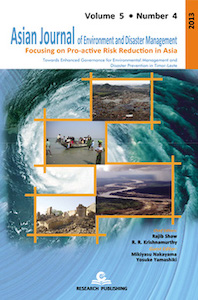 Asian Journal of Environment and Disaster Management
(Chief editor until 2015)
Asian Journal of Environment and Disaster Management
(Chief editor until 2015)-
- Suresh D., Zhang Y., Cao Y. and Shaw R. (2024): Climate Change Adaptation Strategies for Grape Cultivation in Yamanashi Prefecture of Japan. In Rural and Regional Development. 2024, 2 (1), 10001; https://doi.org/10.35534/rrd.2024.10001
- Poudel S., Wickramasinghe D., Mukherjee M., Chowdhooree I., Chimi C., Mishra B., Abhinay K., Mitra S., Shaw R. (2024): The status and prospect on nature-based solution in South Asia: A policy-based analysis, in PLOS Climate, https://doi.org/10.1371/journal.pclm.0000289
- M Nasif Ahsan, M. Mohibbullah, Animesh K. Gain, Fatema Khatun, Md. Ashiqur Rahman, Afri Sultana, Rezwanul Haque, Md. Mostafizur Rahman, Khan Rubayet Rahaman, Karina Vink, Rajib Shaw (2024): ‘We knew a cyclone was imminent’: Hazard preparedness and disaster management efficiency nexus in coastal Bangladesh, International Journal of Disaster Risk Reduction, Volume 102, 104240, https://doi.org/10.1016/j.ijdrr.2024.104240
- Chauhan P., Akiner M. E., Shaw R. (2024): Forecast future disasters using hydro-meteorological datasets in the Yamuna River basin, Western Himalaya: Using Markov Chain and LSTM approaches in Artificial Intelligence in Geosciences 5 (2024) 100069
- Septikasari Z., Retnawati H., Wilujeng I., Shaw R. and Handaka I. B. (2024): Needs assessment: strategy of integration disaster education at elementary schools in disaster prone areas, Journal of Education and Learning, DOI: https://doi.org/10.11591/edulearn.v18i1.20921
- Kaklauskas A., Shaw R., Kaklauskiene L., Ruddock L., Massimo Bianchi, Ubarte I., Kliukas R., Milevicius V., Tupenaite L., Stasiukynas A. (2024): A holistic approach to evaluate the synergies and trade-offs of city and country success, Ecological Indicator, https://doi.org/10.1016/j.ecolind.2024.111595
- Kawane, T.; Adu-Gyamfi, B.Cao, Y.; Zhang, Y.; Yamazawa, N.; He, Z.; Shaw, R. (2024): Digitization as an Adaptation and Resilience Measure for MSMEs amid the COVID-19 Pandemic in Japan: Lessons from the Food Service Industry for Collaborative Future Engagements. Sustainability 2024, 16, 1550. https:// doi.org/10.3390/su16041550
- Amarakoon V., Dharmarathne G., Premasiri R., Mukherjee M., Shaw R. and Wickramasinghe D. (2024): Potential for the complementary and integrative use of citizen science and modern science in flood risk reduction: A case study from Sri Lanka, International Journal of Disaster Risk Reduction, Volume 103, March 2024, 104331
- Shaw R. and Kishore K. (2023): Disaster risk reduction and G20: A major step forward, in Progress in Disaster Science, Volume 17, Available from: https://www.sciencedirect.com/science/article/pii/S2590061723000017
- Shaw R. (2023): Repositioning Earthquake Risk Reduction: Implications to Global Risk Landscape, Journal of Disaster Research, Volume 18, Number 6, 649-655.
- Otaki T. and Shaw R. (2023): Cost Estimates and Policy Challenges of Transporting Renewable Energy Derived Ammonia from Gujarat, India to Japan, In: Hydrogen, 2023, 4(4), 961-974; https://doi.org/10.3390/hydrogen4040056
- Kawane T., Adu-Gyamfi B., Shaw R. (2023): Exploring the elements of strengthening online higher education in disaster risk reduction: a perspective of sustained strategy in post COVID-19, In: International Journal of Disaster Resilience in the Built Environment, 1759-5908, DOI 10.1108/IJDRBE-12-2022-0125
- Samarakkody A., …. Shaw R. (2023): Inclusivity in online and distance disaster education: A review of educators' views, In: Progress in Disaster Science 20 (2023) 100298
- Yildiz A., Dickinson J.,…Shaw R. (2023): Effects of disaster education on children's risk perception and preparedness: A quasi-experimental longitudinal study. In: Geographical Journal, DOI: 10.1111/geoj.12556
- Prashar N., Lakra H S., Shaw R. and Kaur H. (2023): Urban Flood Resilience: A comprehensive review of assessment methods, tools, and techniques to manage disaster, In: Progress in Disaster Science 20 (2023) 100299
- Kawane T., Zhao R., Ozaki Y., Otaki T., Mazumder S. and Shaw R. (2023): Local Production, Consumption, and Innovation: Enhancing Sustainability through SMEs in Japan, In: Rural and Regional Development, https://doi.org/10.35534/rrd.2023.10008
- Mitra, P.; Zhang, Y.; Mitra, B.K.; Shaw, R. (2023): Assessment of Impacts and Resilience of Online Food Services in the Post-COVID-19 Era. Sustainability 2023, 15, 13213. https://doi.org/10.3390/su151713213
- Agustianingsih, D.P., Ariyaningsih, , Shaw, R. (2023): , Community disaster resilience using multi-hazard assessment during Covid-19: The case of Denpasar, Indonesia, Natural Hazard Research (2023), doi: https://doi.org/10.1016/j.nhres.2023.04.006.
- Ariyaningsih; Shaw, R. (2023): Community-Based Approach for Climate Resilience and COVID-19: Case Study of a Climate Village (Kampung Iklim) in Balikpapan, Indonesia. Land 2023, 12, 650. https://doi.org/10.3390/land12030650
- Kogachi, A.; Shaw, R. (2023): Application of Sustainable Livelihood Approach (SLA) to Address Climate-Induced Risks through the Lens of Africa Borderland. Climate 2023, 11, 65. https://doi.org/10.3390/cli11030065
- Mitra A. and Shaw R. (2023): Systemic risk management in India: An analytics perspective, Progress in Disaster Science 18 (2023) 100279
- Yamazawa N., Ozaki Y., Shaw R. (2023): Role of Youth in Implementing SDGs Future City in Tosacho, Kochi, Japan, https://doi.org/10.35534/rrd.2023.10004
- Dixit A. and Shaw R. (2023): Smart Cities in Nepal: The concept, evolution and emerging patterns, Urban Governance, elsevier.com/locate/ugj
- Otaki, T.; Shaw, R. The Potential of Collaboration between India and Japan in the Hydrogen Sector. Energies 2023, 16, 3596. https://doi.org/10.3390/en16083596
- Jiang Y and Shaw R. (2023): Spatial Characteristics and Influencing Factors of Migration in Kanagawa, Japan, Rural and Regional Development, 2023, 1, 10002, https://doi.org/10.35534/rrd.2023.10002
- Agustianingsih, D.P., Ariyaningsih, , Shaw, R., Community disaster resilience using multi-hazard assessment during Covid-19: The case of Denpasar, Indonesia, Natural Hazard Research (2023), doi: https://doi.org/10.1016/j.nhres.2023.04.006.
- Pereira J., Bhyiyan R. T., Muhammed N., Yang S. and Shaw R. (2023): Advancing science, technology and innovation for disaster risk reduction: The Kuala Lumpur Consensus on Disaster Risk Reduction, DOI : https://doi.org/10.7186/wg491202303
- Li J., Liu J., D. B., Pan J. Shaw R. and Shoji T. (2023): Medical resource accessibility in areas with frequent and hazardous debris flows, International Journal of Disaster Risk Reduction, Volume 95, September 2023, 103873
- Senanayake, A.C.; Samarakkody, A.; Malalgoda, C.; Amaratunga, D.; Haigh, R.; Liyanage, C.; Hamza, M.; Kaklauskas, A.; Shaw,R. (2023): Towards an Inclusive Disaster Education: The State of Online Disaster Education from the Learner’s Perspective. Sustainability 2023, 15, 11042. https://doi.org/10.3390/su151411042
- Mukherjee M., Kumar A., Rahman M., Yangdhen, S., Sen S., Adhikari B., Nianthi R., Sachdev S. and Shaw R. (2023): Extent and evaluation of critical infrastructure, the status of resilience and its future dimensions in South Asia, Progress in Disaster Science 17 (2023) 100275
- Prashar N., Lakra H. S., Kaur H. and Shaw R. (2023): Urban flood resilience: mapping knowledge, trends and structure through bibliometric analysis, in Environment, Development and Sustainability, https://doi.org/10.1007/s10668-023-03094-3
- Zakianis; Lestari, F.; Fauzia, S.; Fitria, L.; Zulys, A.; Hartono, B.; Muzanni, A.; Satyawardhani, S.A.; Shaw, R.; Prabowo, S. Identification of Hazardous Waste Risk Level in Central Java Province, Indonesia. Sustainability 2023, 15, 6390. https://doi.org/10.3390/su15086390
- Thapa, P. S., Adhikari, B. R., Shaw, R., Bhattarai D. and Yanai, S. (2023): Geomorphological analysis and early warning systems for landslide risk mitigation in Nepalese mid‑hills, in Natural Hazards, https://doi.org/10.1007/s11069-023-05929-8
- Ahmed M. S., Sarmah T., Dabral A., Chatterjee R., Shaw R. (2023): Unpacking systemic, cascading, and compound risks: A case based analysis of Asia Pacific, In Progress in Disaster Science, Volume 18, April 2023, 100285
- Shaw, R., Y. Luo, T.S. Cheong, S. Abdul Halim, S. Chaturvedi, M. Hashizume, G.E. Insarov, Y. Ishikawa, M. Jafari, A. Kitoh, J. Pulhin, C. Singh, K. Vasant, and Z. Zhang (2022): Asia. In: Climate Change 2022: Impacts, Adaptation, and Vulnerability. Contribution of Working Group II to the Sixth Assessment Report of the Intergovernmental Panel on Climate Change [H.-O. Pörtner, D.C. Roberts, M. Tignor, E.S. Poloczanska, K. Mintenbeck, A. Alegría, M. Craig, S. Langsdorf, S. Löschke, V. Möller, A. Okem, B. Rama (eds.)]. Cambridge University Press, Cambridge, UK and New York, NY, USA, pp. x-y. https://doi.org/xxx.
- Isetani S., Shimizu S., DeWit A. and Shaw R. (2022): Indo-Japanese collaboration on energy security and critical raw material (CRM), in The Asia Pacific Journal, Volume 20, Issue 8, Number 5, Available from: https://apjjf.org/2022/18/Isetani-Shimizu-DeWit-Shaw.html?fbclid=IwAR3Ik3sjJXJsRnM2y0jWJFco41cmw19s4jzRFes7xt9QBlnzwT1JfWR1Cxw
- Ozaki, Y.; Shaw, R. (2022): Citizens’ Social Participation to Implement Sustainable Development Goals (SDGs): A Literature Review. Sustainability 2022, 14, 14471. https://doi.org/10.3390/su142114471
- Mitra A. and Shaw R. (2022): Systemic risk from a disaster management perspective: A review of current research, in Environment Science and Policy, Volume 140, 122-133, https://www.sciencedirect.com/.../pii/S1462901122003690...
- Izumi T. and Shaw R. (2022): A multi-country comparative analysis of the impact of COVID-19 and natural hazards in India, Japan, the Philippines, and USA, In International Journal of Disaster Risk Reduction, Volume 35, https://doi.org/10.1016/j.ijdrr.2022.102899
- Morey, Bhumika, Sameer Deshkar, Vibhas Sukhwani, Priyanka Mitra, Rajib Shaw, Bijon K. Mitra, Devesh Sharma, Md. A. Rahman, Rajarshi Dasgupta, and Ashim K. Das. 2022. "Towards Circulating and Ecological Sphere in Urban Areas: An Indicator-Based Framework for Food-Energy-Water Security Assessment in Nagpur, India" Sustainability 14, no. 13: 8123. https://doi.org/10.3390/su14138123
- Nakum V., Sulfikkar M. Isetani S., Chatterjee R., Shaw R. and Soma H. (2022): Developing a framework on school resilience for risk-informed decision-making, in Progress in Disaster Science, 15, 100237, https://doi.org/10.1016/j.pdisas.2022.100237
- Sukhwani, V. and Shaw, R. (2022): Conjoint assessment of rural water security and system sustainability in Nagpur, India, in International Journal of Disaster Resilience in the Built Environment, https://doi.org/10.1108/IJDRBE-08-2021-0093
- Mukherjee, M.; Wickramasinghe, D.; Chowdhooree, I.; Chimi, C.; Poudel, S.; Mishra, B.; Ali, Z.F.; Shaw, R. (2022): Nature‐based Resilience: Experiences of Five Cities from South Asia. Int. J. Environ. Res. Public Health 2022, 19, 11846. https://doi.org/10.3390/ijerph191911846
- Urano S., Kawane T., Kanbara S. and Shaw R. (2022): Immersive learning based on an attempt at global cultural exchange, in Social Work Social Welfare, 4 (1): 206-215. Available at: https://www.syncsci.com/.../article/view/SWSW.2022.01.00
- Urano S. and Shaw R. (2022): Democracy Through Web 3: Co-creating the Future with Tensegrity. International Journal of Science, Technology and Society. Vol. 10, No. 4, 2022, pp. 160-165. doi: 10.11648/j.ijsts.20221004.15
- Urano S. and Shaw R. (2022): Understanding Monad from the Perspectives of Bioinformatics. International Journal of Science, Technology and Society. Vol. 10, No. 4, 2022, pp. 155-159. doi: 10.11648/j.ijsts.20221004.14
- Sakurai, M.; Shaw, R. (2022): The Potential of Digitally Enabled Disaster Education for Sustainable Development Goals. Sustainability 2022, 14, 6568. https://doi.org/10.3390/su14116568
- Mathuria S., Lakra H. S., Goswami A., Shaw R. and Parihar A. (2022): Framework for geospatial flood exposure mapping of schools in Himalayan region for climate change adaptation and resilient school design, International Journal of Disaster Risk Reduction (2022), doi: https://doi.org/10.1016/j.ijdrr.2022.103069.
- Adu-Gyamfi B., Zuquan H., Yamazawa N., Kato A. and Shaw R. (2022): Reflections on science, technology and innovation on the aspirations of the Sendai framework for disaster risk reduction, in International Journal of Disaster Resilience in the Built Environment, https://www.emerald.com/insight/content/doi/10.1108/IJDRBE-06-2022-0062/full/html?fbclid=IwAR0igcTakDzrq3mUUoyi71Fv5h8Z96BBouW_z1Stmva19yc788_UP3ceeDo
- Chan, E.Y.Y., Guha-Sapir, D., Dubois, C.; Shaw, R., Wong, C.S. (2022): Challenges of Data Availability and Use in Conducting Health-EDRM Research in a Post-COVID-19 World. In: Int. J. Environ. Res. Public Health 2022, 19, 3917. https://doi.org/10.3390/ijerph19073917
- Panwar V., Sen S. and Shaw R. (2022): Introducing proactive sovereign disaster risk financing in India: Potentials and challenges, International Journal of Disaster Risk Reduction, Volume 70, 15 February 2022, 102760
- Ariyaningsih, Sukhwani V. and Shaw R. (2022): Vulnerability assessment of Balikpapan (Indonesia) for climate change-induced urban flooding, in International Journal of Disaster Resilience in the Built Environment, https://doi.org/10.1108/IJDRBE-08-2021-0111
- Okita Y., Glassey S., Shaw R. (2022): COVID-19 and the expanding role of international urban search and rescue (USAR) teams: the case of the 2020 Beirut explosions, in Journal of International Humanitarian Action, https://doi.org/10.1186/s41018-022-00116-z
- Adu Gyamfi B. and Shaw R. (2022): The impact of COVID-19 pandemic on public engagement approached to disaster preparedness for foreign residents: case of Tokyo Metropolitan Area, Japan, in International Journal of Disaster Reduction in Built Environment, 1759-5908, DOI 10.1108/IJDRBE-08-2021-0095
- Adu-Gyamfi, B.; Shaw, R. (2022): Risk Awareness and Impediments to Disaster Preparedness of Foreign Residents in the Tokyo Metropolitan Area, Japan. Int. J. Environ. Res. Public Health 2022, 19, 11469.https://doi.org/10.3390/ijerph191811469
- Das A., Rahman A., Mitra P., Sukhwani V., Shaw R., Mitra B., Sharma D., Deshkar S. and Morey B. (2022): Up‑scaling organic agriculture to enhance food and water security in South Asia. Organic Agriculture, https://doi.org/10.1007/s13165-022-00403-4
- Ansari, M.S.; Warner, J.; Sukhwani, V.; Shaw, R. (2022): Protection Motivation Status and Factors Influencing Risk Reduction Measures among the Flood-Prone Households in Bangladesh. Int. J. Environ. Res. Public Health 2022, 19, 11372. https://doi.org/10.3390/ijerph191811372
- Ansari, S.; Warner, J.; Sukhwani, V.; Shaw, R. (2022): Implications of Flood Risk Reduction Interventions on Community Resilience: An Assessment of Community Perception in Bangladesh. Climate 2022, 10, 20. https://doi.org/10.3390/cli10020020
- Wataya, E.; Shaw, R. (2022): Soft Assets Consideration in Smart and Resilient City Development. Smart Cities 2022, 5, 108–130. https://doi.org/10.3390/smartcities5010007
- Izumi, T.; Das, S.; Abe, M.; Shaw, R. (2022): Managing Compound Hazards: Impact of COVID-19 and Cases of Adaptive Governance during the 2020 Kumamoto Flood in Japan. Int. J. Environ. Res. Public Health 2022, 19, 1188. https://doi.org/10.3390/ijerph19031188
- Kanbara, S.; Shaw, R. (2022): Disaster Risk Reduction Regime in Japan: An Analysis in the Perspective of Open Data, Open Governance. Sustainability, 14, 19. https://doi.org/10.3390/su14010019
- Parvin G. A., Dasgupta R.,….Shaw R. (2022): Disaster experiences, associated problems and lessons in southwestern coastal Bangladesh: exploring through participatory rural appraisal to enhance resilience, in Sustainable and Resilient Infrastructure, https://www.tandfonline.com/doi/full/10.1080/23789689.2022.2138165
- Shaw R., Sakurai A., and Oikawa Y. (2021): New realization of disaster risk reduction education in the context of a global pandemic: lessons from Japan, in International Journal of Disaster Risk Science, https://doi.org/10.1007/s13753-021-00337-7
- Kato A. and Shaw R. (2021): Urban stress and climate change issues: potential role of Yoga, Keio SFC Journal, Volume 21, Number 2, 72-99
- Sukhwani V and Shaw R. (2021): Stakeholder perception in addressing water stress in Nagpur, India: lessons for enabling participatory governance, Keio SFC Journal, Volume 21, Number 2, 122-143
- Ahsan N., Kumar P., Dasgupta R., Johnson B., Shaw R. (2021): Promise, premise and reality: the case of voluntary environmental non-migration despite climate risks in coastal Bangladesh, in Regional Environmental Change, 22, https://doi.org/10.1007/s10113-021-01864-1
- Mitra, P.; Shaw, R., Sukhwani, V.; Mitra, B.K.; Rahman, M.A.; Deshkar, S.; Sharma, D. (2021): Urban–Rural Partnership Framework to Enhance Food–Energy–Water Security in the Post-COVID-19 Era. Int. J. Environ. Res. Public Health 2021,18, 12493. https://doi.org/10.3390/ijerph182312493
- Dabral A., Bajwa S., Shioyama S., Chatterjee R. and Shaw R. (2021): Social innovation hackathon for driving innovation in disaster risk reduction (DRR), Journal of Integrated Disaster Risk Management, IDRiM (2021) 11 (1) ISSN: 2185-8322 DOI10.5595/001c.28876
- Soma H., Sukhwani V., Shaw R. (2021): An approach to determine the linkage between livelihood assets and the housing conditions in the urban slums of Dhaka, in Journal of Urban Management, Available from: https://www.sciencedirect.com/science/article/pii/S222658562100090X
- Sukhwani V., Napitupulu H., Jingnan D., Yamaji M. and Shaw R. (2021): Enhancing cultural adequacy in post-disaster temporary housing, in Progress in Disaster Science, available from:https://www.sciencedirect.com/science/article/pii/S2590061721000466?via%3Dihub
- Vahidi S., Taleai M., Yan W. and Shaw R. (2021): Digital Citizen Science for Responding to COVID-19 Crisis: Experiences from Iran, in International Journal of Environmental Research and Public Health, https://www.mdpi.com/1660-4601/18/18/9666
- Paudel S., Kumar P., Paudel, S.; Kumar, P.; Dasgupta, R.; Johnson, B.A.; Avtar, R.; Shaw, R.; Mishra, B.K.; Kanbara, S. (2021): Nexus between Water Security Framework and Public Health: A Comprehensive Scientific Review. Water 2021, 13, 1365. https://doi.org/10.3390/w13101365
- Mohanty S., Dabral A., Chatterjee R. and Shaw R. (2021): Shelter management during pandemics: lessons from cascading risks of cyclones and COVID-19 in International Journal of Disaster Resilience in the Built Environment, https://doi.org/10.1108/IJDRBE-09-2020-0103
- Adu-Gyamfi, B.; Shaw, R. (2021): Characterizing Risk Communication and Awareness for Sustainable Society: The Case of Foreign Residents in the Tokyo Metropolitan Area of Japan. Sustainability 2021, 13, 5786. https://doi.org/10.3390/su13115786
- Adu-Gyamfi B. and Shaw R. (2021): Utilizing Population Distribution Patterns for Disaster Vulnerability Assessment: Case of Foreign Residents in the Tokyo Metropolitan Area of Japan, in International Journal of Environmental Research and Public Health, 2021, 18, 4061.https://doi.org/10.3390/ijerph18084061
- Safitri Y., Ningsih R., Agustianingsih D., Sukhwani V. and Kato A., Shaw R. (2021): COVID-19 impact on SDGs and the fiscal measures: case of Indonesia, International Journal of Environmental Research and Public Health, 2021, 18, 2911, https://doi.org/10.3390/ijerph18062911
- Singh C., Jain G., Sukhwani and Shaw R. (2021): Losses and damages associate with slow onset events: urban drought and water insecurity in Asia, in Current Opinion of Environmental Sustainability, 50, 72-86.
- Chan, E.Y.Y.; Dubois, C., Fong, A.H.Y.; Shaw, R.; Chatterjee, R.; Dabral, A.; Loyzaga, A.; Kim, Y.-k.; Hung, K.K.C.; Wong, C.S. (2021): Reflection of Challenges and Opportunities within the COVID-19 Pandemic to Include Biological Hazards into DRR Planning. Int. J. Environ. Res. Public Health 2021, 18, 1614. https://doi.org/10.3390/ijerph18041614
- Bajwa S., Dabral A., Chatterjee R. and Shaw R. (2021): Co-Producing Knowledge Innovation through Thematic Incubators for Disaster Risk Reduction and Sustainable Development in India, Sustainability, 2021, 13, 2044. https://doi.org/ 10.3390/su13042044
- Bismark Adu-Gyamfi B., Shaw R., and Ofuso B. (2021): Identifying exposures of health facilities to potential disasters in the Greater Accra Metropolitan Area of Ghana, International Journal of Disaster Risk Reduction 54 (2021) 102028
- Marome, W., Shaw, R. (2021): COVID‐19 Response in Thailand and its Implications on Future Preparedness. Int. J. Environ. Res. Public Health 2021, 18, 1089. https://doi.org/10.3390/ijerph18031089
- Otsuyama K. and Shaw R. (2021): Exploratory case study for neighborhood participation in recovery process: A case from the great East Japan earthquake and tsunami in Kesennuma, Japan, Progress in Disaster Science, https://doi.org/10.1016/j.pdisas.2021.100141
- Shaw R. (2020): Thirty years of science and technology, and academia in disaster risk reduction and emerging responsibilities, in International Journal of Disaster Risk Science, https://doi.org/10.1007/s13753-020-00264-z
- Kato A. and Shaw R. (2020): Yoga and stress management during and post COVID-19 urban lifestyle in Japan, Asian Journal of Complementary and Alternative Medicine, Volume 8, Issue 3, 48-54
- Sukhwani V. and Shaw R. (2020): A Water-Energy-Food Nexus-Based Conceptual Approach for Developing Smart Urban-Rural Linkages in Nagpur Metropolitan Area, India, In Journal of Integrated Disaster Risk Management, 10 (1): DOI 10.5595/001c.1118539
- Dewit A., Shaw R. and Djlante R. (2020): An integrated approach to sustainable development, national resilience and COVID-19 responses: The case of Japan, In International Journal of Disaster Risk Reduction, 51 (2020) 101808
- Izumi T., Sukhwani V., Surjan A. and Shaw R. (2020): Managing and responding to pandemics in higher educational institutions: initial learning from COVID-19, in International Journal of Disaster Resilience in the Built Environment, doi: 10.1108/IJDRBE-06-2020-0054
- Hua J. and Shaw R. (2020): Corona virus “infodemic” and emerging issues through a data lens: the case of China, in International Journal of Environmental Research and Public Health, 17, 2309; doi:10.3390/ijerph17072309
- Shaw R., Kim Y and Hua J.(2020): Governance, technology and citizen behavior in pandemic: lessons from COVID-19 in east Asia, in Progress in Disaster Science, http://dx.doi.org/10.1016/j.pdisas.2020.100090
- Zhang H. and Shaw R. (2020): Identifying research trends and gaps in the context of COVID-19, in in International Journal of Environmental Research and Public Health, 17, 3370; doi:10.3390/ijerph17103370
- Chan E. et al., Shaw R. (2020): Narrative review of health-EDRM primary prevention measures for vector borne disease, in International Journal of Environmental Research and Public Health, 17 (16): 5981, doi: 10.3390/ijerph17165981
- Djlante R., Shaw R. and Dewitt A. (2020): Building resilience against biological hazards and pandemics: COVID-19 and its implications for Sendai framework, in Progress in Disaster Science, http://dx.doi.org/10.1016/j.pdisas.2020.100080
- Chatterjee R., Bajwa S., Dwivedi D., Kanji R., Ahammed M., and Shaw R. (2020): COVID-19 risk assessment tool: dual application of risk communication and risk governance, in Progress in Disaster Science, http://dx.doi.org/10.1016/j.pdisas.2020.100109
- Tashiro A. and Shaw R. (2020): COVID-19 pandemic response in Japan: what is behind the initial flattening of the curve? Sustainability, 12, 5250; doi:10.3390/su12135250
- Sukhwani V. Deshkar S. and Shaw R. (2020): COVID-19 lockdown, food systems and urban rural partnership: Case of Nagpur, India, in International Journal of Environmental Research and Public Health, 17, 5710; doi:10.3390/ijerph17165710
- Mavrodieva A. and Shaw R. (2020): Disaster and climate change issues in Japan’s Society 5.0, in Sustainability, 12, 1893; doi:10.3390/su12051893
- Nurzaman A., Shaw R. and Roychansyah Md. S. (2020): Measuring community resilience against coastal hazards: Case study in Baron beach, Gunungkidul regency, Progress in Disaster Science, http://dx.doi.org/10.1016/j.pdisas.2020.100067
- Bera S., Guru B., Chatterjee R. and Shaw R. (2020): Geographic variation of resilience to landslide hazard: A household based comparative study of Kalimpong hilly region, India, In International Journal of Disaster Risk Reduction, 46 (2020) 101456
- Adu-Gyamfi B., Shaw R. and Yan W. (2020): Assessment of housing exposure to accelerated coastal erosion in Keta municipality of Ghana, In International Journal of Disaster Risk Reduction 44 (2020) 101450
- Mohanty S., Chatterjee R. and Shaw R. (2020): Building resilience of critical infrastructure: a case of impacts of cyclones on the power sector in Odisha, in Climate, 2020, 8, 73; doi:10.3390/cli8060073
- DeWit A., Djlante R. and Shaw R. (2020): Building holistic strategy, Tokyo’s 2050 strategy, in The Asia Pacific Journal, Volume 18, Issue 7, Article ID: 5386
- Okita Y., Shaw R. and Minato Y. (2020): Regulating incoming international search and rescue teams in the response phase, in Journal of Contingency and Crisis Management, DOI: 10.1111/1468-5973.12305
- Okita Y and Shaw R. (2020): Search and rescue team classification: BASARNAS of Indonesia, in Australian Journal of Emergency Management, Vol 35, No. 2, April, 73-79
- Okita Y. and Shaw R. (2020): Standard setting and its implementation through the classification system for international urban search and rescue, Journal of emergency Management, Vol 18, No. 3, 239-245
- Shah A., Ye J., Shaw R. and Ullah R. (2020): Factors affecting flood-induced household vulnerability and health risks in Pakistan: the case of Khyber Pakhtinkhwa (KP) province, in International Journal of Disaster Risk Reduction, 42 (2020) 101341
- Sukhwani V and Shaw R. (2020): Operationalizing crowdsourcing through mobile application for disaster management in India, in Progress in Disaster Science, (2020) 100052
- Mukherjee M, …, Shaw R. (2020): Ecosystem-centric business continuity planning (eco-centric BCP): a post COVID-19 new normal, in Progress in Disaster Science, 7 (2020) 100117
- Chan E., …Shaw R. (2020): Narrative review on health EDRM primary prevention measures for vector borne diseases, in International Journal of Environmental Research and Public Health, 17, 5981; doi:10.3390/ijerph17165981
- Chan E.,….Shaw R. (2020): Narrative review of non-pharmaceutical behavioural measures for the prevention of COVID-19 (SARS-CoV-2) based on the Health-EDRM framework, In British Medical Bulletin, 1-42, doi: 10.1093/bmb/ldaa030
- Okita Y. and Shaw R. (2020): Two levels of decision making in receiving international search and rescue, in Development in Practice, https://doi.org/10.1080/09614524.2020.1809636
- Dasgupta R., Basu M., Kumar P., Johnson B., Mitra B., Avtar R. and Shaw R. (2020): A rapid indicator-based assessment of foreign resident preparedness in Japan during typhoon Hagibis, in International Journal of Disaster Risk Reduction, 51 (2020) 101849
- Linh T., Hanh T., Shaw R. (2020): COVID-19 initial preparedness and response in Vietnam during the first six months of the pandemic and the lessons for Sendai framework implementation, International Journal of Disaster Resilience in the Built, DOI 10.1108/IJDRBE-07-2020-0080
- Sukhwani V., Thapa K., Shaw R., Deshkar S., Mitra B. and Yan W. (2020): Addressing Urban–Rural Water Conflicts in Nagpur through Benefit Sharing, Water, 12, 2979; doi:10.3390/w12112979
- Sukhwani V., Shaw R., Deshkar S., Mitra B., Yan W. (2020): Role of Smart Cities in Optimizing Water-Energy-Food Nexus: Opportunities in Nagpur, India, Smart Cities 2020, 3(4), 1266-1291; https://doi.org/10.3390/smartcities3040062
- Thapa K., Sukhwani V., Deshkar S., Shaw R., and Mitra B. (2020): Urban-Rural Resource Flow through Regional Circular and Ecological Sphere (R-CES) Approach in Nagpur, India, in Sustainability, 12, 8663; doi:10.3390/su12208663
- Prabhakar SVRK and Shaw R. (2020): International investments and businesses as enablers of globalization of local risks: A case for risk communication and climate fragility reduction, Progress in Disaster Science, http://dx.doi.org/10.1016/j.pdisas.2020.100125
- Kumar P., Avtar R., Dasgupta R. Johnson B., Mukherjee A., Ahsan N., Nguyen D., Nguyen H, Shaw R., Mishra B. (2020): Socio-hydrology: A key approach for adaptation to water scarcity and achieving human well-being in large riverine islands, Progress in Disaster Science, http://dx.doi.org/10.1016/j.pdisas.2020.100134
- Chan E., Wong CS., Hung, K, Kalonji G., Cui P., Zhou G and Shaw R. (2020): Report of Alliance of International Science Organizations on Disaster Risk Reduction (ANSO-DRR) Conference 2020, in International Journal of Environmental Research and Public Health, 17, 8772; doi:10.3390/ijerph17238772
- Mavrodieva A., Daramita RI., Arsono A., Yawen L. and Shaw R. (2018): Role of civil society in sustainable urban renewal (machizukuri) after the Kobe earthquake, in Sustainability, 11, 335; doi:10.3390/su11020335
- Mavrodieva A, ….. , Shaw R. (2019): Role of social media as a soft power tool in raising public awareness and engagement in addressing climate change, in Climate, 2019, 7, 122; doi:10.3390/cli7100122
- Mavrodieva A,, …., Shaw R. (2019): Governmental incentivization from SMEs’ engagement in disaster resilience in southeast Asia, in International Journal of Disaster Risk Management, Vol. 1, No. 1, pp. 32-50
- Mavrodieva A. and Shaw R. (2020): Enabling private sector engagement in disaster resilience in south and East Asia, in Risk, Hazards and Crisis in Public Policy, in doi: 10.1002/rhc3.12175
- Okita Y. and Shaw R. (2019): Effects of the classification system in international SAR: the case of the 2015 Nepal earthquake, in Disaster Prevention and Management, 10.1108/DPM-08-2018-0240
- DasGupta R., Shaw R. Basu M. (2019): Implication and management of coastal salinity for sustainable community livelihood: Case study from the India Sundarban Delta, https://doi.org/10.1016/B978-0-12-810473-6.00013-3
- Fujita K and Shaw R. (2020): Preparing international joint project: use od Japanese flood hazard maps in Bangladesh, in International Journal of Disaster Risk Management, Vol. 1, No. 1, pp. 62-80
- Izumi T. Shaw R. et al. (2020): Disaster risk reduction and innovation, in Progress in Disaster Science 2 (2019) 100033
- Parvin G., Sakamoto M., Shaw R., et al. (2019): Evacuation scenario of cyclone Aila in Bangladesh: investigating the factors influencing evacuation decision and destination, in Progress in Disaster Science 2 (2019) 100032
- Shah A., Shaw R. et al. (2019): Current capacities, preparedness and needs of local institutions in dealing with disaster risk reduction in Khyber Pakhtinkhwa (KP), Pakistan, in International Journal of Disaster Risk Reduction 34 (2019) 165–172
- Mohamed S., Rahman A., Shaw R. (2019): Spatial appraisal of flood risk assessment and evaluation using integrated hydro-probabilistic approach in Panjkora river basic, Pakistan, in Environment Monitoring and Assessment, https://doi.org/10.1007/s10661-019-7746-z
- Sukhwani V., …, Shaw R. (2019): Understanding the barriers restraining the effective operation of flood early warning system, in International Journal of Disaster Risk Management, https://doi.org/10.18485/ijdrm.2019.1.2.1
- Sukhwani V., Shaw R. et al. (2019): Optimizing food-energy-water nexus to foster collective resilience in urban rural system, in Progress in Disaster Science 1 (2019) 100005
- Sukhwani V., …, Shaw R. (2019) : Enhancing food security by institutionalizing collaborative food alliance in urban areas, in Sustainability 2019, 11, 4103; doi:10.3390/su11154103
- Wayata E., and Shaw R. (2019): Measuring the value and the role of soft assets in smart development in, Cities 94 (2019) 106–115
- Sadik, M. S., Nakagawa, H., Rahman, R., Shaw, R., Kawaike, K. & Fujita, K., (2018): A Study on Cyclone Aila Recovery in Koyra, Bangladesh: Evaluating the Inclusiveness of Recovery with Respect to Pre disaster Vulnerability Reduction in International Journal of Disaster Risk Science. 9, 1, p. 28-43 16 p.
- Ray, B. & Shaw, R. (2018): Changing built form and implications on urban resilience: Loss of climate responsive and socially interactive spaces, in Procedia Engineering. 212, p. 117-124
- Shaw R. (2018): Role of Private Sectors in Disaster Risk Reduction: Potential and Challenges, in Journal of Disaster ResearchVol.13 No.7, 1207-1212
- Hayashi H., Shaw R. and Doterty B. (2018): Exploring the Possibility of an Online Synthesis System for Disaster Risk Reduction as a Tool to Promote “Consilience” of Knowledge and Practice, in Journal of Disaster ResearchVol.13 No.7, 1213-1221
- Koike T., XXX, Shaw R. and Ikeda T. (2018): Role Played by Science and Technology in Disaster Risk Reduction: From Framework Planning to Implementation, in Journal of Disaster ResearchVol.13 No.7, 1222-1232
- Kamruzzaman Md and Shaw R. (2018): Flood and Sustainable Agriculture in the Haor Basin of Bangladesh: A Review Paper, in Universal Journal of Agricultural Research 6(1): 40-49
- Oktari RS, Shiwaku K., Munadi K., and Shaw R. (2018): Enhancing community resilience towards disaster: The contributing factors of school-community collaborative network in the tsunami affected area in Aceh In International Journal of Disaster Risk Reduction, 29, 3-12
- Parvin G., Rahman R., Fujita K., Shaw R. (2018): Overview of flood management actions and policy planning in Bangladesh, in International Journal of Public Policy, Vol 14, No. 5/6, 423-443
- Sadik S., Nakagawa H., Rahman R., Shaw R., Kawaike K., Parvin G. and Fujita K. (2018): Humanitarian Aid Driven Recovery of Housing after Cyclone Aila in Koyra, Bangladesh: Characterization and Assessment of Outcome in Journal of Japan Society of Natural Disaster Science, 37. 73-91
- Sadik S., Nakagawa H., Rahman R., Shaw R., Kawaike K. and Fujita K. (2018): A Study on Cyclone Aila Recovery in Koyra, Bangladesh: Evaluating the Inclusiveness of Recovery with Respect to Pre-disaster Vulnerability Reduction, in International Journal of Disaster Risk Science, https://doi.org/10.1007/s13753-018-0166-9
- Shah A., Shaw R. and others (2018): Current capacities, preparedness and needs of local institutions in dealing with disaster risk reduction in Khyber Pakhtunkhwa, Pakistan, in International Journal of Disaster Risk Reduction, https://doi.org/10.1016/j.ijdrr.2018.11.014
- Shi P., Shaw R. and other (2018): Fourteen Actions and Six Proposals for Science and Technology-Based Disaster Risk Reduction in Asia, in International Journal of Disaster Risk Science, https://doi.org/10.1007/s13753-018-0174-9
- Fang C., Shaw R. and others (2017): The Sendai Framework for Disaster Risk Reduction 2015-2030 and DBAR DRR, in Chinese Academy of Science, No, 61, 1-10.
- Das Gupta R. and Shaw R. (2017): Disaster risk reduction: a critical approach, in The Routledge Handbook of Disaster Risk Reduction Including Climate Change Adaptation Routledge https://www.routledgehandbooks.com/doi/10.4324/9781315684260.ch3
- Oktari R., Shiwaku K., Munadi K., syamsidik, Shaw R. (2017): Enhancing community resilience towards disaster: The contributing factor of school-community collaborative network in the tsunami affected area in Aceh in International Journal for Disaster Risk Reduction, Volume 29, 3-12.
- Scheyvens H., Shaw R. and others (2017): Promoting the landscape approach in Asia-Pacific developing countries: key concepts and ways forward, IGES Policy Brief, Number 37, 12 pages.
- Sadik S., Nakagawa H., Rahman, R. and Shaw R. and others (2017): Systematic study of cyclone Aila recovery efforts in Koyra, Bangladesh… in Journal of Society of Natural Disaster Science, 36, 109-121.
- Shaw R., Izumi T. and Shi P. (2016): Perspectives of Science and Technology in Disaster Risk Reduction of Asia, in International Journal of Disaster Risk Science, 7, 329-342.
- Parvin G. A., Shimi A. C., Shaw R. and Biswas C. (2016): Flood in a changing climate: the impact on livelihood and how the rural poor cope in Bangladesh, in Climate, 4, 60; doi:10.3390/cli4040060
- Das Gupta R. and Shaw R. (2016): Perspective insight into incentive design and sustainability of participatory mangrove management: a case study from the Indian Sundarbans, in Journal of Forest Research, DOI 10.1007/s11676-016-0355-6
- Shiwaku K., Ueda Y., Oikawa Y. and Shaw R. (2016): School disaster resilience assessment in the affected areas of East Japan earthquake and tsunami, in Natural Hazards, DOI: 10.1007/s11069-016-2204-5
- Poudel S. and Shaw R. (2016): The Relationships between Climate Variability and Crop Yield in a Mountainous Environment: A Case Study in Lamjung District, Nepal, in Climate, Volume 4, No. 13; doi:10.3390/cli4010013
- Ueda Y. and Shaw R. (2015): Managing and bridging communities in temporary housing: case of the Great East Japan Earthquake and Tsunami in Kesennuma City, Japan, in Natural Hazards, DOI 10.1007/s11069-015-1984-3
- Izumi T. and Shaw R. (2015): A new approach of disaster management in Bangladesh: private sector involvement, in Risk Hazards, Crisis in Public Policy, DOI: 10.1002/rhc3.12069
- Oktari R., Shiwaku K., Munadi K., Syamsidik and Shaw R. (2015): A conceptual model of a school-community collaborative network in enhancing coastal community resilience in Banda Aceh, Indonesia, in International Journal of disaster Risk Reduction, http://www.sciencedirect.com/science/article/pii/ S2212420915000199
- Chatterjee, R., Shiwaku, K., Gupta, R. D., Nakano, G., & Shaw R. (2015): Bangkok to Sendai and beyond: Implications for disaster risk reduction in Asia. International Journal of Disaster Risk Science, 6(2), 177-188.
- Matsuura S. and Shaw R. (2015): Exploring the possibilities of school based recovery and community building in Toni district, Kamaishi, in Natural Hazards, Vol. 75, Issue 1, 613-633
- Srivastava N. and Shaw R. (2015): Occupational resilience to floods across the urban rural domain in grater Ahmedabad, International Journal of disaster Risk Reduction,http://www.sciencedirect.com/science/article/pii/S2212420914001228
- Abedin A. and Shaw R. (2014): Safe drinking water adaptability for salinity, arsenic and drought risk in southwest of Bangladesh, in Risk Hazards and Crisis in Public Policy, Volume 5, Issue 2, 62-82
- Abedin A., Habiba U. and Shaw R. (2014): Community perception and adaptation to safe drinking water scarcity: salinity, arsenic and drought risks in coastal Bangladesh, in International Journal of Disaster Risk Science, DOI 10.1007/s13753-014-0021-6
- Das Gupta R. and Shaw R. (2014): An indicator based approach to assess coastal communities’ resilience against climate related disaster in Indian Sundarbans, in Journal of Coastal Conservation, DOI 10.1007/s11852-014-0369-1
- Fernandez G. and Shaw R. (2014): Participation of Youth Councils in Local-Level HFA Implementation in Infanta and Makati, Philippines and Its Policy Implications, in Risk Hazards and Crisis in Public Policy, Volume 5, Issue 3, 259-278
- Hiwasaki L., Luna M., Syamsidik and Shaw R. (2014): Process for integrating local and indigenous knowledge with science for hydro-meteorological disaster risk reduction and climate change adaptation in coastal and small island communities, International Journal of Disaster Risk Reduction, 10, 15-27.
- Joerin J., Shaw R., Takeuchi Y. and Krishnamurthy R. (2014): The adoption of a climate disaster resilience index in Chennai, India, Disaster, 38 (3): 540-561
- Krishnamurthy R., DasGupta R., Chatterjee and Shaw R. (2014): Managing the Indian coast in the face of disaster and climate change: a review and analysis of India’s coastal zone management policy, in J. Coastal conservation, DOI 10.1007/s11852-014-0339-7
- Srivastava N. and Shaw R. (2014): Establishing parameters for identification of vulnerable occupations in a disaster scenario in Gujarat, India, in Risk Hazards and Crisis in Public Policy, Volume 5, No. 212-238
- Luo Y., Shaw R. Lin H. and Joerin J. (2014): Assessing response behavior of debris flow affected communities in Kaohsiung, Taiwan, in Natural Hazards, Vol. 74, Issue 3, 1429-1448
- Habiba U. and Shaw R. (2014). Enhancing Farmers Resilience to Cope with Climate Induced Drought in Northwestern Bangladesh. Journal of Disaster Research, Vol.8 No.1, 203-204.
- Das Gupta R., Shaw R. (2013): Cumulative impacts of human interventions and climate change in mangrove ecosystem of south and south east Asia: An overview, in Journal of Ecosystem, http://dx.doi.org/10.1155/2013/379429
- Basu M. and Shaw R. (2013): Water policy, climate change and adaptation in South Asia, in International Journal of Environmental Studies, DOI:10.1080/ 00207233.2013.781736
- Hori T. and Shaw R. (2013): Global climate change perception, local risk awareness and disaster risk reduction: A case study of Cartago city, Costa Rica, in Risk, Hazards and Crisis in Public Policy, 3(4): 77-104
- Matsuoka Y. and Shaw R. (2013): Hyogo Framework for Action for an assessment tool of risk reduction: case of Philippines national progress and Makati city, in Risk, Hazards and Crisis in Public Policy, 3(4): 18-39
- Matsuoka Y., Shaw R. and Takeuchi Y. (2013): Implementation of Hyogo Framework for Action in Makati, accepted for publication in International Journal of Disaster Resilience for the Built Environment, Volume 4, Issue 1, 23-42
- DasGupta, R., & Shaw R. (2013). Changing perspectives of mangrove management in India–An analytical overview. Ocean & Coastal Management, 80, 107-118.
- Mulyasari F., Shaw R., and Takeuchi Y.(2013): Women as disaster risk Reduction drivers in Bandung, Indonesia: Paving towards a resilient community, in Disasters (in press)
- Mulyasari F. and Shaw R. (2013): Role of women as risk communicators to enhance disaster resilience in Bandung, Indonesia, in Natural Hazards. DOI 10.1007/s11069-013-0798-4
- Mulyasari F., Inoue, S., Prashar, S., Isayama, K., Basu M., Srivastava N. and Shaw R. (2013): Disaster preparedness: Looking through the lens of hospitals in Japan, in International Journal of Disaster Risk Science, 4(2): 89-100. doi:10.1007/s13753-013-0010-1
- Parvin G. A. and Shaw R. (2013): Role of micro-finance institutions in coastal communities disaster risk reduction, response and recovery: a case study of Hatiya, Bangladesh, Disasters, Vol. 37, Issue 1, 165-184
- Srivastava, N. and Shaw R. (2013), Establishing Urban-rural linkage elements for growth and poverty reduction in India, Asian Journal of Environment and Disaster Management, Vol.5, No.1, 81-102
- Fernandez, G. and Shaw R. (2013) Youth Participation in Disaster Risk Reduction through Science Clubs in the Philippines. Disasters Journal. UK: Overseas Development Institute
- Fernandez, G. and Shaw R. (2013) Youth Council Participation in Disaster Risk Reduction in Infanta and Makati, Philippines: A Policy Review. International Journal of Disaster Risk Science. 4 (3).
- Uy, N. and Shaw R. (2013). Ecosystem resilience and community values: Implications to ecosystem-based adaptation. Journal of Disaster Research 8(1), 201-202.
- Uy N., Takeuchi Y. and Shaw R. (2012): An ecosystem based resilience analysis of Infanta, Philippines, in Environmental Hazards, DOI:10.1080/17477891. 2012.688794
- Habiba U., Shaw R., Takeuchi Y. (2012): Farmer’s Perception and Adaptation Practices to Cope with Drought: Perspectives from Northwestern Bangladesh, accepted for publication International Journal of Disaster Risk Reduction, http://dx.doi.org/10.1016/j.ijdrr.2012.05.004
- Izumi T. and Shaw R. (2012): Effectiveness and challenges for an Asian NGO network for disaster reduction and response, accepted for publication in Risk, Hazards and Crisis in Public Policy, 2(2), 1-16
- Izumi T. and Shaw R. (2012): Role of stakeholders in disaster risk reduction under Hyogo Framework for Action: An Asian Perspective, accepted for publication in Asian Journal of Environment and Disaster Management, Vol. 4, No. 2, 164-182
- Joerin J., Shaw R., Takeuchi Y. and Krishnamurthy R. (2012): Assessing community resilience to climate related disasters in Chennai, India, in International Journal of Disaster Risk Reduction, http://dx.doi.org/10.1016/j.ijdrr.2012.05.006
- Joerin J., Shaw R., Takeuchi Y. and Krishnamurthy R. (2012): Action-oriented Resilience Assessment of Communities in Chennai, India, in Environmental Hazards, DOI:10.1080/17477891.2012.689248
- Matsuoka Y. and Shaw R. (2012): Improvements and challenges of Japanese disaster management system, in Asian Journal of Environment and Disaster Management, Vol. 4, no. 2, 119-144.
- Peary B., Shaw R. and Takeuchi Y. (2012): Utilization of social media in the East Japan Earthquake and Tsunami and its effectiveness, accepted for publication in Journal of Natural Disaster Science, Volume 34, Number 1, 3-18.
- Prashar S. and Shaw R. (2012): Urbanization and hydro-meteorological disaster resilience: the case of Delhi, International Journal of disaster resilience for the built environment, volume 3, number 1, 7-19.
- Prashar S., Shaw R. and Takeuchi Y. (2012): Community Action Planning in East Delhi: A Participatory Approach to Build Urban Disaster Resilience, accepted for publication in Mitigation and Adaptation Strategies for Global Change, DOI 10.1007/s11027-012-9368-4
- Prashar S. and Shaw R. (2012): Disaster resilience of slums in Delhi through appropriate risk communication, in Asian Journal of Environment and Disaster Management, volume 4, number 1, 99-117
- Kinh T., Nguyen H. and Shaw R. (2012): Impacts of climate related disaster on fisheries in Danang, Vietnam, in Asian Journal of Environment and Disaster Management, volume 4, number 1, 17-36
- Prabhakar SVRK, Iwata Y., Shaw R., Soulakova J., Takeuhci K. Kunita T. (2012): Climate change implications for disaster risk management in Japan: A case study on perceptions of risk management, personnel and communities in Saijo city, in Environmental Hazards, DOI:10.1080/17477891.2011.618821
- Fujita K., Shaw R. and Takeuchi Y. (2012): Linking mountain community practices and sediment related disaster risk reduction in Reihoku, Accepted in Asian Journal of Environment and Disaster Management, Vol. 4, No. 2, 224-245.
- Tong T., Shaw R. and Takeuchi Y. (2012): Climate Disaster Resilience of the Education Sector in Thua Thien Hue Province, Central Vietnam, Natural Hazards 63(2): 685-709.
- Fujita K., Takeuchi Y. and Shaw R. (2011): Voluntary Self-Help Organization and Fire Volunteer for Mountain Disaster Risk Reduction in Reihoku Area, Japan, in Asian Journal of Environment and Disaster Management, Volume 3, number 3, 317-337
- Hori T. and Shaw R. (2011): Opportunities and Challenges of Incorporating Climate Change Threats into Disaster Risk Management Planning: A Case Study in Costa Rica, in Risk, Hazards and Crisis in Public Policy, Volume 2, Issue 2, Article 3, DOI: 10.2202/1944-4079.1062
- Hori T. and Shaw R. (2011) "Incorporation of Potential Climate Change Impacts into Local Disaster Risk Management in Costa Rica," in Risk, Hazards & Crisis in Public Policy: Vol. 2: Issue. 4, Article 3, DOI: 10.2202/1944-4079.1094
- Parvin, G. and Shaw R. (2011) "Climate Disaster Resilience of Dhaka City Corporation: An Empirical Assessment at Zone Level," in Risk, Hazards & Crisis in Public Policy: Vol. 2: Issue. 2, Article 6., DOI: 10.2202/1944-4079.1069
- Gwee Q., Takeuchi Y., Jet-chau W., and Shaw R. (2011): Disaster education system in Yunlin county, Taiwan, in Asian Journal of Environment and Disaster Management, Volume 3, Number 2, 189-204
- Habiba U., Shaw R. and Takeuchi Y. (2011): Drought risk reduction through SIP approach in northwestern region of Bangladesh, Environmental Hazards, 10, 2, 121-138.
- Uy N., Takeuchi Y., Shaw R. (2011): Local adaptation towards livelihood resilience: a case study in Albay, Philippines, in Environmental Hazards, 10, 2, 139-153
- Shaw R. (2011): Climate change adaptation research in south Asia: an overview, in Asian Journal of Environment and Disaster Management, Volume 2, Number 4, 397-427
- Tran P., Marincioni F. and Shaw R. (2010): Catastrophic flood and forest cover change in the Huong river basin, Central Viet Nam: A gap between common perceptions and facts, in Journal of Environmental Management, 91, 2186-2200
- Fujita K. and Shaw R. (2010): Environmental changes and Japan’s forest management, in Asian Journal of Environment and Disaster Management, Volume 2, Number 2, 153-178
- Shiwaku K., Fujieda A., Takeuchi Y. and Shaw R. (2010): Utilization of disaster experiences in school disaster education in disaster affected areas, in Journal of Natural Disaster Science, 29-1, 83-95 (in Japanese)
- Shimi A. C., Parvin G., Biswas C. and Shaw R. (2010): Impact and adaptation to flood: a focus on water supply, sanitation and health problems of rural communities in Bangladesh, in Disaster Prevention and Management, Volume 19, No. 3, 298-313
- Hoang V. H., Shaw R. and Kobayashi M. (2010): Flood risk management in RUA of Hanoi: the need for synergy of urban development and risk management policies. In Disaster Prevention and Management, Volume 19, No. 1, 103-118.
- Sugimoto M., Iemura H., Shaw R. (2010): Tsunami high poles and disaster awareness: memory, education and awareness of disaster on the reconstruction for resilient city in Banda Aceh, Indonesia, in Disaster Prevention and Management, Volume 19, No. 5, 527-540
- Nguyen H., Prabhakar SVRK, Shaw R. (2009): Adaptive Drought Risk Reduction in Cambodia: Reality, Perceptions and Strategies, in Environmental Hazards, 8, 245-262, Springer Publication.
- Surjan A. and Shaw R. (2009): Enhancing disaster resilience through local environmental management: A Case of Mumbai, India: In Disaster Prevention and Management, Volume 1, Number 2, 139-164.
- Takeuchi Y. and Shaw R. (2009): Gender dimension in risk communication: A perspective from sediment disaster in Hiroshima, Japan, in RDD Special Volume Gender and Disaster, Vol.30, No.1, 63-75, UNCRD Press.
- Imura M. and Shaw R. (2009): Challenges and potentials of post disaster relocation: In Disaster Prevention and Management, Volume 1, Number 2, 197-219.
- Mimaki J., Takeuchi Y., Shaw R. (2009): The role of community-based organization in the promotion of disaster preparedness at the community level: a case study of a coastal town in the Kochi Prefecture of the Shikoku Region, Japan. In: Journal of Coastal Conservation, 13: 207-215.
- Shaw R. and Takeuchi Y., Krishnamurthy R., Pribadi K., Nianthi R. (2009): Collaborative post tsunami action research: lessons and reflections, in Asian Journal of Environment and Disaster Management, Volume 1, Number 1, 13-24
- Iwasaki S. and Shaw R. (2009): Human Security and Coping Brackish Environmental Hazards in Fishing Communities of Songkhla Lake, Thailand, in Asian Journal of Environment and Disaster Management, Volume 1, Number 1, 65-78
- Razafindrabe, Bam H. N. Gulsan Ara Parvin, Surjan, Akhilesh, Takeuchi Yukiko, Shaw Rajib (2009): Climate Disaster Resilience: Focus on Coastal Urban Cities in Asia, in Asian Journal of Environment and Disaster Management, Volume 1, Number 1, 101-116
- Shaw R. (2008): An overview of urban risk in South Asia: issues, approaches and thoughts, In Journal of South Asia Disaster Studies, Volume 1, Number 1, 69-84.
- Shaw R. (2008): Kechamatan development Program, Indonesia, Case study in Building Resilient Communities, the World Bank, 243-267.
- Shaw R. (2008): Malawi Social Action Fund, Case study in Building Resilient Communities, the World Bank, 281-296.
- Shaw R. (2008): Pakistan Poverty Alleviation Fund, Case study in Building Resilient Communities, the World Bank, 297-316.
- Iwasaki S. and Shaw R. (2008): Fishery Resource Management in Chilika Lagoon: A Study on Coastal Conservation in the Eastern Coast of India, in: Journal of Coastal Conservation, 12, 43-52.
- Parvin G., Takahashi F., Shaw R. (2008): Coastal hazards and community coping methods in Bangladesh, Journal of Coastal Conservation, 12, 181-193.
- Rekha Nianthi and Shaw R. (2008): Climate change research in Sri Lanka: In Special Volume on Sri Lanka, 73-96.
- Razafindrabe B., Bin H., Inoue S., Ezaki T. and Shaw R. (2008): The role of forest sand density in controlling soil erosion: implications to sediment related disasters in Japan. In Environmental Monitoring and Assessment, DOI 10.1007/s10661-008-0699-2
- Prabhakar SVRK, Srinivas A., Shaw R. (2008): Climate change and local level disaster risk reduction planning: need, opportunities and challenges, In: Mitigation and Adaptation Strategies of Global Climate Change, DOI 10.1007/s11027-008-9147-4
- Surjan A. and Shaw R. (2008): ‘Eco-city’ to ‘Disaster Resilient Eco-Community’: a concerted approach in the coastal city of Puri, India: In Sustainability Science, 3, 249-265.
- Shiwaku K. and Shaw R. (2008): Proactive co-learning: A new paradigm in disaster education. In Disaster Prevention and Management, An International Journal, Vol. 17, No. 2, p. 183-198.
- Shaw R. and Takeuchi Y. (2007): Indigenous knowledge and technology for disaster reduction: In: Asia Pacific Tech Monitor, special volume, Nov-Dec, 20-26.
- Prabhakar SVRK and Shaw R. (2007): Climate change adaptation implication and drought risk mitigation: a perspective from India. In: Climatic Change, 88, 113-130.
- Mimaki J. and Shaw R. (2007): Enhancement of disaster preparedness with social capital and community capacity: A perspective from a comparative case study of rural communities in Kochi, Japan. In: SUISUI Hydrological Research Letters 1, 5-10
- Tran P., Shaw R., Chantry G. and Norton J., (2007): GIS and local knowledge in disaster management: A Case study of flood risk mapping of Vietnam: In Disasters, 33(1), 152-69
- Tran P., Marincioni F., Shaw R., Sarti M. and An L.V. (2008): Flood Risk Management in Central Viet Nam: Challenges and Potentials. In Natural Hazards, 46, 119-138.
- Tran P. and Shaw R. (2007): Towards an integrated approach of disaster and environmental management: A case study of Thua Thien Hue province in Central Vietnam: In Environmental Hazards 7(4): 271-282
- Miyaguchi T. and Shaw R. (2007): Corporate community interface in disaster management: A preliminary study from Mumbai, India. In Risk Management, 9, 209-222.
- Hoang V. H., Shaw R. and Kobayashi M. (2007): Flood risk management in RUA of Hanoi: importance of community perception in catastrophic flood risk in disaster risk planning. In Disaster Prevention and Management, An International Journal: 16 (2), 245-258.
- Shiwaku, K., Shaw R., Kandel R.C., Shrestha S. and Dixit A. (2007): Future perspective of school disaster education in Nepal: Disaster Prevention and Management, An International Journal. Vol. 16, No. 4, 576-587
- Shiwaku, K., Shaw R., Kandel R.C., Shrestha S. and Dixit A. (2006): Promotion of Disaster Education in Nepal: The Role of Teachers as Change Agents: International Journal of Mass Emergency and Disasters, Vol. 24, No.3: 403-420.
- Shaw R. (2006): Critical issues of community based flood mitigation: examples from Bangladesh and Vietnam, Journal of Science and Culture, Special Issue on Flood Disaster Risk Reduction in Asia, volume 72, No. 1-2, 62-71.
- Shaw R. (2006): Indian Ocean tsunami and aftermath: need for environment-disaster synergy in the reconstruction process, Special volume In Disaster Prevention and Management, An International Journal, vol. 50, no.1, p 5-20.
- Uitto J. and Shaw R. (2006): Adaptation to changing climate: promoting community based approaches to developing countries, Sansai, Vol.1, page 93-108.
- Shaw R. (2006): Critical issues of community based flood mitigation: examples from Bangladesh and Vietnam, In Japanese: Journal of Natural Disaster Science, 24-3, page 234-246.
- Nakagawa Y. and Shaw R. (2004): Social Capital: A missing link to disaster recovery, International Journal of Mass Emergency and Disaster, Volume 22, no. 1, 5-34
- Shaw R., Shiwaku K., Kobayashi H. and Kobayashi M. (2004): Linking experience, knowledge, perception and earthquake preparedness, In Disaster Prevention and Management, Volume 13. No.1, 39-49.
- Shaw R. and Goda K. (2004): From disaster to sustainable community planning and development: the Kobe Experiences, In Disaster, 28 (1), 16-40.
- Shaw R. (2003): Role of non-government organizations in earthquake disaster management: as Asian perspective, In Regional Disaster Dialogue, Volume 24, No. 1, 117-129.
- Sharma A., Gupta M., Bajaj R. and Shaw R. (2003): From disaster to sustainable community recovery: challenges and lessons learned, In Regional Disaster Dialogue, Volume 24, No. 1, 53-61.
- Okazaki K. and Shaw R. (2003): Empowerment of local people for sustainable disaster mitigation: experiences from developing countries, In Regional Development Dialogue, Volume 24, No. 1, 3-14.
- Shaw R. K. and Sinha R. (2003): Towards sustainable recovery: future challenges after Gujarat earthquake, In Risk Management: An International Journal, Volume 5, No.2, 35-51.
- Shaw R., Gupta M., and Sharma A. (2003): Community recovery and its sustainability: lessons from Gujarat earthquake of India, In Australian Journal of Emergency Management, Volume 18, No. 2, 28-34.
- Shaw R. K. et al. (2002) International Cooperation in the post-disaster scenario: A case study from Gujarat, India. Journal for Natural Disaster Science, Volume 24, N. 2, 73-82
- Shaw R. K. and Sinha R. (2001): Preliminary observations and aftermath of Gujarat earthquake India, GIS and Development, vol. 3, pp 10-12.
- Shaw R. K. and Arima M. (1998): A corundum-quartz assemblage from the Eastern Ghats Granulite Belt, India: evidence for high P-T metamorphism? In Journal of Metamorphic Geology, Volume 16, No. 2, 189-196, Blackwell Science Inc.
- Shaw R. K. et al. (1997): Proterozoic events in the Eastern Ghats Belt, India: evidence from Rb-Sr, Sm-Nd systematics and SHRIMP dating. In Journal of Geology, Volume 105, 645-656, Chicago University Press
- Shaw R. K. and Arima M. (1997): Retrograde pressure-temperature path for spinel-bearing metapelites in Rayagada, Eastern Ghats, India In Journal of Mineralogy and Petrology, Volume 60, 41-59, Springer Verlag
- Shaw R. K., Venkatesh T.L. and Gupta A.K.(1993): Experimental Study of the System Fluorapatite-Chlorapatite Under 10 and 12 Kbar at 640, 750 and 900deg C, In National Academy of Science Letters, Volume 16, 27-36, India
Reports
This report summarizes 10 key lessons from West Japan Flood with specific focus on Mabi area. The report is based on direct field survey, interviews and other reports.
Download the report from: Lessons-From-Mabi
30 Innovations for DRR includes the innovative products and approaches considered to be extremely effective and those that have already contributed to reducing disaster risks. They were identified in discussions between experts primarily from Keio University, University of Tokyo, United Nations University, CWS Japan, and IRIDeS of Tohoku University. This does not imply that only thirty innovations exist to date, rather that many others also exist. They were identified as the very best of many innovations in discussions between experts. The DRR innovations listed in this publication are divided into products (14) and approaches (16). The innovations listed first in each section are those applied for 1) multi-hazards. The list continues with specific hazard types: 2) Earthquake, 3) Flood, and 4) Others. In this format, readers can easily identify the DRR innovations suitable for tackling the hazards that affect them most.
Please download: 30 Innovations for Disaster Risk Reduction


